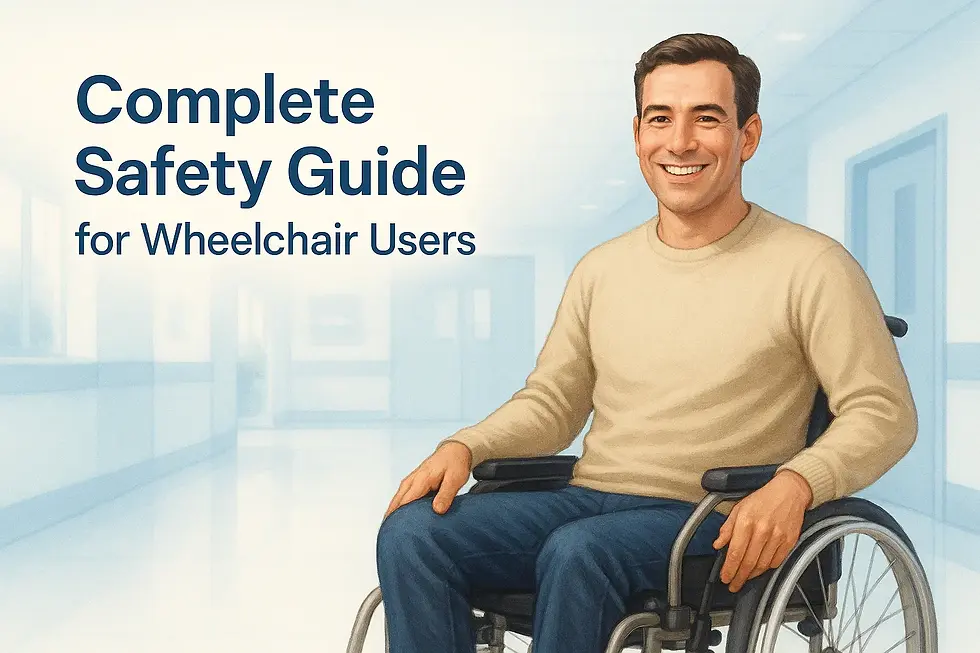Types of Wheelchairs: Complete Safety Guide for Beginners
- eshedogra07
- 11 hours ago
- 3 min read

For the overwhelmed caregiver, choosing the right wheelchair can feel like navigating a maze. Beyond comfort and price, safety is the most critical factor. Whether you’re considering a manual chair for temporary use or a motorized one for long-term independence, knowing the different types of wheelchairs and their safety implications can prevent accidents, reduce injuries, and improve quality of life.
1. Safety-First Introduction to Types of Wheelchairs:
When you look at wheelchairs, they typically fall into two broad categories:
Require the user or caregiver to push.
Best for short-term or low-mobility needs.
Safety considerations: Risk of strain for caregivers, tipping if used on uneven terrain, requires strong brakes.
Electric Wheelchairs (Powered)
Run on batteries, controlled by joystick or remote.
Best for long-term users, those with limited upper body strength, or progressive conditions.
Safety considerations: Requires regular charging, careful maneuvering indoors, risk of collisions in crowded spaces.
👉 When each type is appropriate:
Manual: Short-term recovery, lighter mobility restrictions, easy transportation.
Electric: Severe mobility limitations, elderly patients living independently, outdoor movement over long distances.

Wheelchair Selection Guide: Understanding when to choose a manual or electric wheelchair based on mobility needs, from supporting long-term fitness and short-term recovery to addressing severe and temporary mobility limitations.
Common safety mistake to avoid: Choosing based on budget alone, without considering environment and physical ability.
2. Tutorial: How to Assess Your Loved One’s Needs
Before buying, do a mobility and safety assessment:
Step-by-step checklist
Can the patient propel themselves or rely on caregiver support?
How much daily movement is required (indoors vs outdoors)?
Any history of falls, dizziness, or balance issues?
Weight and body size (check weight capacity).
Safety red flags
Frequent falls → need anti-tip wheels.
Weak upper body → powered wheelchair is safer.
Severe breathing issues or posture problems → recliner or tilting wheelchair needed.
Environmental hazard evaluation
Stairs present? Consider stair-climbing wheelchair .
Narrow doors or tight corners? Compact foldable chairs.
Outdoor use on rough roads? Heavy-duty powered options.
3. Basic Safety Features Every Wheelchair Must Have
Whether you choose manual or electric, look for these safety essentials:
Braking systems: Caregiver brakes for manual, electromagnetic brakes for powered.
Seat belts & positioning support: Prevents slipping and posture-related injuries.
Stability & weight capacity: Wide base prevents tipping, always check manufacturer guidelines.
Cushioning & support: Reduces pressure sores for long-term users.
👉 Brands like Karma, Esleh, and Hero provide models with built-in seat belts, anti-tip wheels, and adjustable cushions for added safety.
4. Initial Safety Setup Tutorial
How to Adjust Basic Settings
Set seat height to align knees at 90° angle.
Adjust footrests to prevent dangling (reduces circulation risks).
Test joystick sensitivity (for electric).
Daily Safety Inspection Checklist
Are brakes functioning properly?
Is the seat cushion intact and firm?
Any loose bolts, damaged tires, or low battery (electric)?
Emergency Procedures
Manual wheelchair tip-over: Train caregivers to stabilize from behind.
Electric wheelchair stops suddenly: Switch to manual push mode.
Battery dies outdoors: Carry backup battery (especially in powered models like Esleh).
5. Next Steps: Creating Your Safety-Focused Selection Criteria
Before finalizing, ask these questions to your doctor and wheelchair supplier:
Which type supports my loved one’s medical condition best?
What safety features are non-negotiable for daily use?
Can the wheelchair be serviced easily in my city?
Which models come with warranty & after-sales support?
👉 Explore trusted wheelchair brands:
Need an expert advice on choosing a wheelchair? Call now : +91987697848



Comments